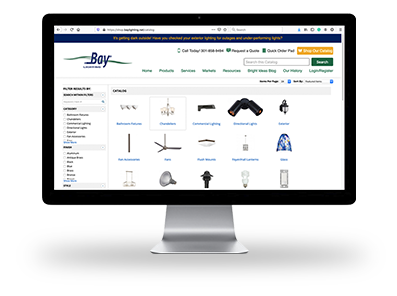Blog
- Home
- Resources
- Bright Ideas Blog
- Using Value Engineering in Lighting Design
Using Value Engineering in Lighting Design

When it comes to a construction project, lighting design can cause a variety of budget and timeline delays due to long production lead times, narrow manufacturer options, over-specified lighting, and more. In these cases, and others, having the project value engineered may help.
Value engineering is the review of new or existing products during the design phase to help increase functionality and value while reducing costs as much as possible. By understanding what value engineering in lighting design is, you’ll be able to choose the best lighting options for your project while improving energy-efficiency and saving money.
What Is Value Engineering?
When it comes to lighting design, value engineering creatively evaluates a variety of options on a lighting project and provides alternative products that either meet or exceed budget expectations (while still achieving the desired project outcome). Value engineering:
- Can happen during the design process of either a retrofit or a new construction project.
- Can take place with existing lighting product specifications.
- Can be a part of the Request for Proposal (RFP) development process.
There are several benefits to value engineering in lighting design, including the ability to:
- Evaluate multiple products.
- Reduce material costs.
- Reduce lifetime operating costs.
- Increase the performance of the product.
While one of the primary goals of value engineering is to save money, it’s important that quality and product outcomes are balanced equally. This will ensure your retrofit or new construction is properly and elegantly lit.
Key Considerations for Value Engineering Lighting
To save money, avoid delays, and have a great value-engineered lighting package, a few considerations to keep in mind include:
- Your value engineering partner must be a lighting expert. They should understand retail-grade vs. commercial-grade lighting vs. custom-fixtures and the importance of appropriate light levels, be familiar with the different lighting controls, know all local codes, and be able to verify all logistics when necessary.
- Discuss budget up front. Budget is one of the first and most important items discussed during the design process. Share a budget in the beginning to set expectations for the engineer and help them to understand what is and isn’t achievable.
- Keep lines of communication open. You should regularly be in touch with the design team, contractors, and value engineer partners. This will help ensure you’re available to evaluate the different lighting options and their associated costs and understand recommendations for optimizing lighting designs to achieve cost and energy savings without sacrificing quality.
- Consider all alternatives. During the value engineering, you’ll be presented with alternative solutions that have similar performance and quality and/or reduced costs. Make sure the performance of the products is indeed similar, the rendering and consistency is correct, the fixtures maintain a consistent aesthetic, and everything is sustainable.
- Factor in long-term maintenance and energy costs. When alternative products are presented, keep in mind the long-term maintenance and costs associated with those new fixtures. You’ll also want to factor in any energy costs or long-term savings associated with the products.
Strategies for Value Engineering Lighting
Some strategies for successful value engineering in lighting design include:
- Using energy-efficient light sources. While energy-efficient lighting may cost a little more in the short-term, the long-term cost savings typically outweighs the up-front expenses. Not only do these lights use less energy, which is better for the environment and your energy bills, but they also last longer and require less maintenance.
- Incorporating daylight. It’s important that lighting levels are considered and not reduced, providing enough light where it’s needed. However, in some cases you may be able to incorporate more natural daylight to reduce the need for certain types of lighting or fixtures.
- Balancing the needs of different spaces. Whether you’re working on an office or other corporate building, apartment building, residential housing, or a similar space, it’s critical to keep in mind that different spaces have different needs. For example, a small bathroom, a main hallway, a bedroom, a kitchen, and a conference room all have different lighting needs when it comes to aesthetics, lighting levels, and performance. When value engineering lighting, these considerations must be kept in mind.
- Maintaining aesthetics while reducing cost. Are fixtures a part of a family of fixtures that maintain a consistent aesthetic? Is the size of the trim and housing the same? Are the fixtures aesthetically similar? Is there visible hardware? Is there consistency? While reducing costs is a major goal of value engineering, it’s important to maintain a beautiful project while also reducing costs.
During value engineering in lighting design, it’s critical that all designers, contractors, and owners collaborate effectively to achieve the best outcomes. Not only should designs be nice to look at, but they should also be sustainable and energy efficient where possible, provide the right light levels, and meet timelines and budgets.
Benefits of Value Engineering Lighting
Value engineering can cause challenges when not executed properly, which is why it’s important to keep in mind the considerations and strategies listed above. However, when done the right way, benefits include:
- Improved energy-efficiency of lighting and savings on energy costs.
- Reduced maintenance costs.
- Increased occupant comfort and productivity due to appropriate lighting levels and aesthetically pleasing fixtures.
- Reduced project costs, both initially and life cycle costs.
- Can help ensure customers aren’t limited to a single manufacturer, but instead can select from a competitive range of product options without compromising quality.
Additionally, it can help meet sustainability goals and reduce the environmental impact of buildings.
Work With an Expert
It can take time to properly value engineer your project. However, when it’s done correctly, the savings and outcomes can be well worth it. Working with experts such as those at Bay Lighting can help ensure your lighting projects for both commercial and residential properties are executed properly and with your best interest (and budget) in mind.
Contact Bay Lighting today online, or call 301-858-9494 to learn more.




